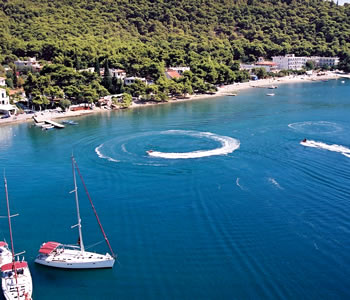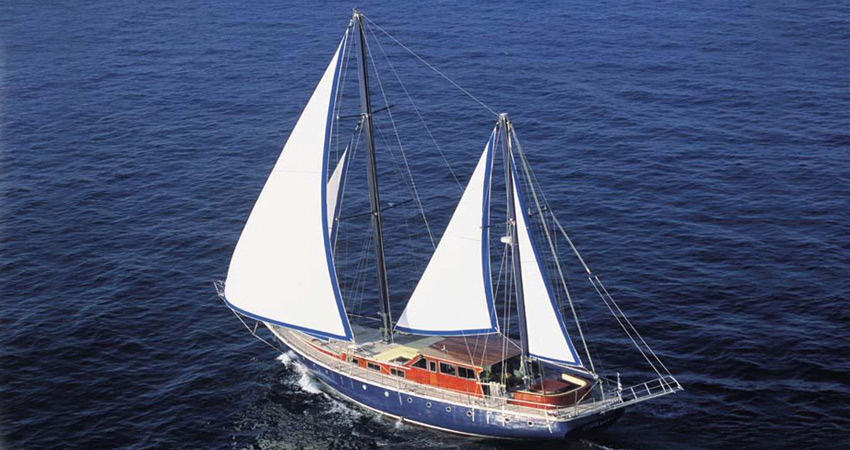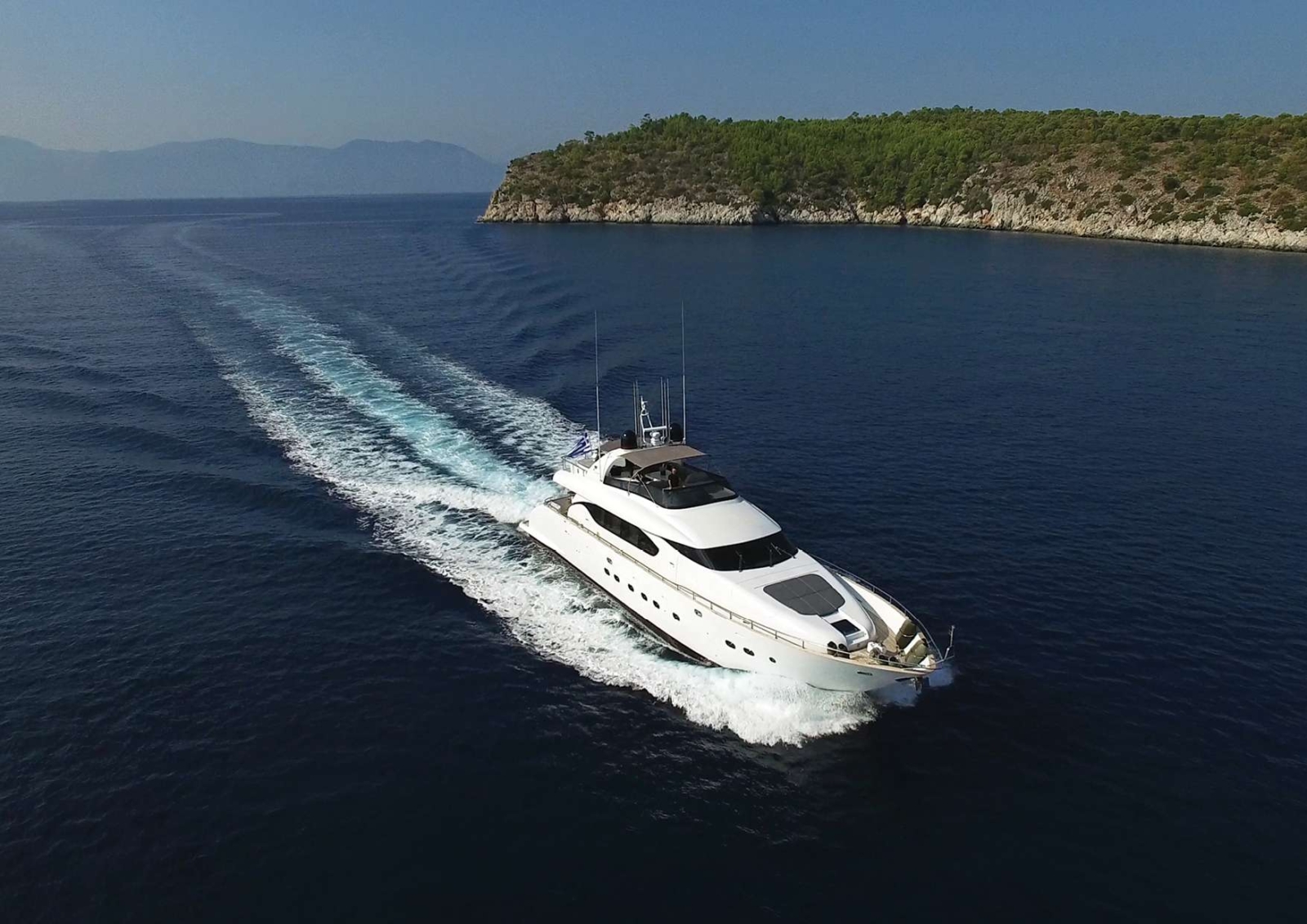ARGO-SARONIC ISLANDS
The rocky, partly volcanic Argo-Saronic islands, most of them barely an olive’s throw from the mainland, differ to a surprising extent not just from the land they face but also from one another. The northernmost island of the Argo-Saronic group, Salamína, is effectively a suburb of Pireas, with its narrow strait, barely a kilometre across, crossed by a constant stream of ferries. There’s little to attract you on the other side, however, and the island is covered only briefly here. Aegina, important in antiquity and more or less continually inhabited since then, is infinitely preferable: the most fertile of the group, it is famous for its pistachio nuts and home to one of the finest ancient temples in Greece. Tiny Angístri is often treated as little more than an adjunct of Aegina, but it’s a lovely place in its own right, ideal for a few days’ complete relaxation. The three southerly islands – green Poros, tiny, car-free Hydra and upmarket Spetses – are comparatively infertile, and rely on water piped or transported in rusting freighters from the mainland.

Given their proximity to Athens and their beauty, the Argo-Saronics are hugely popular destinations, with Aegina almost becoming a city suburb at weekends. Poros, Hydra and Spetses are similar in the summer, though their visitors include a higher proportion of foreign tourists. More than any other group, these islands are best out of season and midweek, when visitors (and prices) fall dramatically and the port towns return to a quieter, more provincial pace.


You’ll also notice a significant difference between Hydra and Spetses, the furthest of the islands, and those closer to Athens – because of the distance, and because they’re accessible only by hydrofoil and catamaran rather than the cheaper conventional ferries, they’re markedly more expensive and exclusive, with significant expat populations. The islands were not extensively settled until medieval times, when refugees from the mainland established themselves here, adopting seagoing commerce (and piracy) as livelihoods. Today, foreigners and Athenians have replaced locals in the depopulated harbour towns; windsurfers, water-taxis and yachts are faint echoes of the massed warships, schooners and kaïkia once at anchor.
EXPLORE THE ISLANDS
A substantial and attractive island with a proud history, less than an hour from Pireás, Aegina is not surprisingly a popular weekend escape from Athens. Despite the holiday homes, though, it retains a laidback, island atmosphere, especially if you visit midweek or out of season. Famous for its pistachio orchards – the nuts are hawked from stalls all around the harbour – the island can also boast substantial ancient remains, the finest of which is the beautiful fifth-century BC Temple of Aphaea, commanding superb views towards Athens from high above the northeast coast.


Hidden gems of Aegina
The floating greengrocers:
Even if you don’t want to buy anything, it will be a feast for your eyes. You won’t find fruit and vegetable sellers like these anywhere else in Greece. It’s a sight worth discovering during your holidays on the island!
The Christos Kapralos Museum:
Just outside the main town, this old studio of one of Greece’s most famous sculptors, houses some of his best-known works and drawings. The bronze portrait of his mother looks out to sea opposite the house, where he summered from 1963-91.
The archaeological site of Kolona:
The sounds and smells of the Aegean wafted over one of the most important prehistoric settlements in Greece for thousands of years, of which only remains exist today. At the end of the 6th century BC, the hill was transformed into a sanctuary, with the Doric temple to Apollo dominating the site. The monolithic column that formed part of the temple was for years a point of reference for Venetian sailors, who named the area Colonna.
Separated from the mainland by a 350m strait, POROS (“the ford”) barely qualifies as an island at all. Popular with Brits and Scandinavians – more than any other Argo-Saronic island, Póros attracts package-holiday operators – it is also busy with weekending Athenians, who can get here by road (via Galatás) or on cheap ferries from Pireás, and with yachties taking advantage of the extensive mooring. There are in fact two islands, Sferia (Poros Town) and the far larger Kalavria, separated from each other by a miniature canal spanned by a bridge. The town is a busy place, with constant traffic of shipping and people: if your stay is longer than a couple of nights you may want to base yourself on Kalávria for a little more peace, coming into town for the food, nightlife and shopping.


Hidden gems of Poros
The Galini villa:
Among the people who stayed here were Seferis, Greta Garbo and Henry Miller. These days you will only be able to admire the exterior of the red neoclassical villa as it is a private residence.
The Russian naval base:
Admire the buildings that have been listed as historical landmarks and then take a dip right in front of them.
A castle fit for conquerors:
Swim to the islet east of the port and conquer its small castle, there since 1827. Back then the locals used it to control the shipping coming from Hydra.
The island of Hydra is one of the most atmospheric destinations in Greece. Its harbour and main town preserved as a national monument, it feels like a Greek island should, entirely traffic-free (even bicycles are banned) with a bustling harbour and narrow stone streets climbing steeply above it. Away from the main settlement the rest of the island is roadless, rugged and barely inhabited. The charm hasn’t gone unnoticed – Ýdhra became fashionable as early as the 1950s, and in the Sixties characters ranging from Greek painter Nikos Hatzikyriakos-Ghikas to Canadian songster Leonard Cohen bought and restored grand old houses here. There’s still a sizeable expat community, which contributes to a relatively sophisticated atmosphere, and also noticeably high prices. But even the seasonal and weekend crowds, and a very limited number of beaches, can’t seriously detract from the appeal. When the town is overrun, it’s easy enough to leave it all behind on foot or by excursion boat. The interior is mountainous and little-visited, so with a little walking you can find a dramatically different kind of island – one of rural cottages, terraces of grain to feed the donkeys, hilltop monasteries and pine forest.


Hidden gems of Hydra
A view of the Aegean from the Windmills:
Climb to the oldest township in Hydra, Kiafa, located high above the harbour. This gem of a town is made up of narrow alleyways, impressive mansions, old grocery stores and boutique hotels. Move on to the seven windmills at the top of the hill of Agios Athanasios. You’ll be rewarded with the view.
Rafalias pharmacy:
The Rafalias family has a history of 400 years on the island. And the pharmacy they founded in Hydra’s alleyways has been maintained the way it was in 1890, when it first opened.
The Prophet and Eros:
Walk all the way up to the monastery of the Prophet Elias (1 hour if you’re fast) and from there, to the top Klimakio of Mount Eros. The panoramic view of Hydra and the Aegean will enchant you.
A popular, upmarket escape for Athenians, SPETSES had brief fame and a vogue as a package destination, largely thanks to John Fowles, who lived here in the early 1950s and used the place, thinly disguised, as the setting for his cult novel The Magus. But the island never developed the mass infrastructure – or the convenient beaches – to match. Today, the town is much the biggest in the Saronic islands, with apartments and villas spreading for several kilometres along the northeast coast, while the rest of the island remains almost entirely uninhabited, with pine forest inland and numerous excellent small beaches around the coast.


Hidden gems of Spetses
The old boatyards:
Did you know that Spetses was the second biggest shipping centre in Greece? In the heart of the Old Port, the sight of old boatyards is sure to impress you. You can still watch the builders work a craft in time-honoured fashion. At the end of your stroll at the old boatyards, under the lighthouse, you’ll find the sculptures of Natalia Mela, gazing out at the Argosaronic.
The benefactor:
The name Sotirios Anargyros means a lot to the locals of Spetses, since he is the one that financed, among other things, the building of the historical Poseidon. His house is located behind Dapia. Built in 1904, it is one of the most beautiful neoclassical homes in Greece.
The beaches:
Agia Marina, Kouzounos, Ksilokeriza, Vrelos, Scholes, Zogeria … crystal-clear waters, secluded beaches with pebbles and sand, shaded by pines are all just walking distance away. And at the beach of Agio Arnargyros, you’ll discover Bekiris Cave, one of the island’s most beautiful natural attractions.
AGISTRI, fifteen minutes by fast boat from Aegina, is a tiny island, obscure enough to be overlooked by most island-hoppers, though the visitors it does have are a diverse mix: Athenian weekenders, retirees who bought and restored property here years ago, plus a few British and Scandinavian package holidaymakers. There’s a small, not terribly attractive strip of development on the north coast facing Aegina, but the rest of the island is pine-covered, timeless and beautiful – albeit with very few beaches. It’s also strangely schizophrenic: holiday weekends can see hordes of young Greeks camping out on otherwise empty beaches, while in Skala a few small, classy hotels are juxtaposed with cafés serving English breakfasts to the package-trippers.


The population of the island is approx. 1.000 inhabitants.
The island consists from many small coves with blue waters, where the pine trees reach the sea. Agistri has got a lot of hills, full of pine trees.












